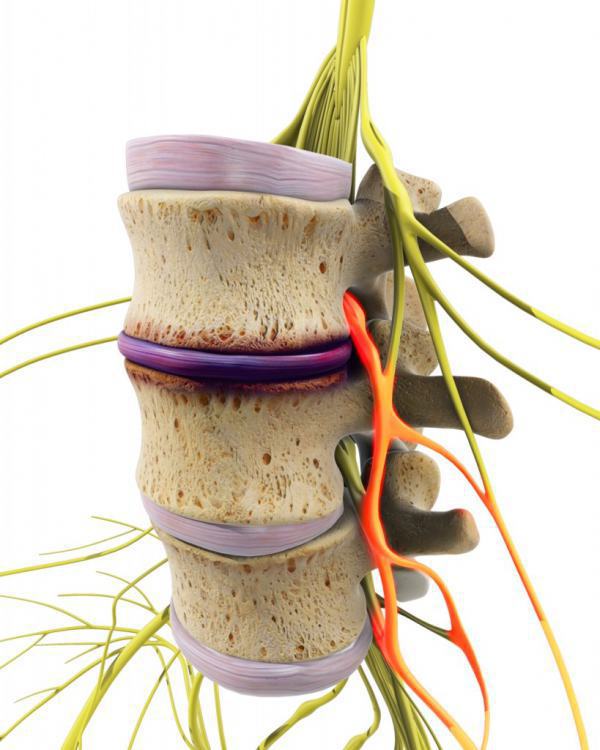Thoracic Spinal Stenosis
Thoracic spinal stenosis occurs when the spinal canal through which the spinal cord travels or the opening through which nerve roots exit the spinal canal narrows. Once the spinal canal narrows, it can press on the spinal cord and/or irritate the nerve roots.
Thoracic spinal stenosis can occur at any of the vertebrae located in the mid-back section from T1 to T12.
Overview
The thoracic spine is located in the mid-back. In this region, vertebrae are attached to the ribs, which is why symptoms such as loss of motion and difficulty rotating the torso may be experienced with thoracic spinal stenosis. This is why thoracic spinal stenosis is so different from cervical or lumbar spinal stenosis.
What Is Thoracic Spinal Stenosis
The spinal canal, located in the mid-region or thoracic spine, can narrow with age. This narrowing of the spinal canal is known as spinal stenosis. Spinal stenosis occurs gradually, slowly reducing the spinal cord’s space and/or room for the nerves in the area. Thoracic spinal stenosis is not as common as other stenosis conditions.
Who is Susceptible to Thoracic Spinal Stenosis
Thoracic spinal stenosis can occur as a result of natural aging; this is why older adults are more prone to develop this condition. However, other factors also play an essential role.
People who suffer from thickened tissues, bone spurs, degenerative disc disease, herniated discs, bulging discs, arthritic spurs, are more likely to develop thoracic spinal stenosis because their spinal canal has been compromised.
Causes of Thoracic Spinal Stenosis
Causes can vary widely, however age is by far the most common cause of thoracic spinal stenosis. In some cases, congenital factors such as being born with a narrower spinal canal can lead to spinal stenosis. Other causes of thoracic spinal stenosis may include:
- Arthritis
- Osteoarthritis
- Thicker ligaments
- Herniated spinal discs
- Excess bone growth
- Degenerated facet joints
- Compression fractures
- Spondylolisthesis
Symptoms of Thoracic Spinal Stenosis
Symptoms of thoracic spinal stenosis are different from symptoms associated with spinal stenosis in the cervical or lumbar spine. The most common symptoms experienced include:
- Limited ability to rotate the torso
- Difficulty moving side to side
- Sharp pain in the back that radiates to the lower back and legs
- Ache or discomfort in the legs
- Difficulty walking
- Bowel or bladder dysfunction
- Paralysis – in rare cases
- Pain in the ribs and/or internal organs
Diagnosis
The diagnosis starts with a full physical examination and a thorough medical history check. During the diagnosis, a physician will assess the current symptoms, movements that may trigger pain, and the severity of the symptoms.
Some imaging tests and other exams can help rule out the presence of tumors, diabetes, arthritis and other conditions that may interfere with the diagnosis.
Exams & Tests
Once the preliminary diagnosis is complete, imaging tests can help confirm the diagnosis and locate the exact source of the problem. The most commonly used exams and tests to diagnose spinal stenosis include:
- X-rays: Used to determine the presence of bone spurs and spinal instability
- MRI: Helps visualize any nerves that are being compressed due to thoracic spinal stenosis
- EMG: Requested when neurological damage is suspected to see irritation or nerve damage
Treatment for Thoracic Spinal Stenosis
Depending on the severity of the condition and the symptoms, both surgical and non-surgical treatments may be used to treat this condition.
Non-surgical Treatments
Through the non-surgical treatment approach, the aim is to reduce irritation and pressure from the nerves to relieve pain. Most non-surgical treatment options include:
- NSAIDs: Non-steroidal anti-inflammatory drugs such as acetaminophen, naproxen, and ibuprofen can help reduce the inflammation which often leads to pain
- Physical Therapy: Sessions of physical therapy exercises that strengthen the muscles in the thoracic region can contribute to lessening the pressure in the area
- Prescription Medications: Neurontin, Lyrica, cortisone or steroid injections can help to block nerve pain and provide immediate pain relief for more severe cases
Surgical Treatments
When conservative treatment has failed to reduce symptoms, or the conditions present may lead to nerve damage or myelopathy, surgical approach may be necessary to treat thoracic spinal stenosis. The Bonati Spine Institute offers an array of procedures to treat thoracic spinal stenosis. These procedures may include:
- Laminectomy/Laminotomy: The removal of the lamina can make more room for the nerves and release pressure from the spinal canal
- Foraminotomy/Foraminectomy: The expansion of the foramen can help increase the space for nerve roots to exit the spinal canal and release pinched nerves
- Discectomy: The removal of a bulging disc or the part that is pressing on nerves can provide pressure release and pain relief
Prevention & Self-Care
Certain lifestyle changes and good daily habits can help maintain a healthy spine and avoid this type of conditions. Some prevention and self-care recommendations include:
- Wearing medical braces specialized for spinal stenosis
- Practicing yoga, swimming, and stretching exercises
- Quitting Smoking
- Maintaining a healthy weight

